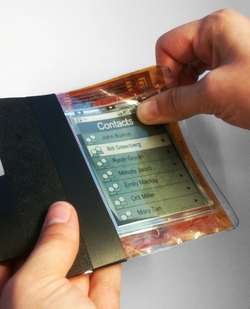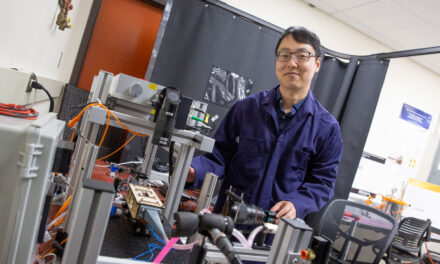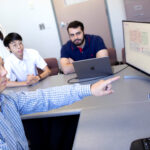
PaperPhone: the next generation of flexible, interactive computing
Posted: May 04, 2011

ASU engineers have contributed to development of a prototype of the Paperphone, a potentially major advance in interactive, mobile computing and flexible technology.
An advanced “thin-film” flexible paper computer has been developed through collaborative efforts of researchers at Queen’s University in Ontario, Canada, and Arizona State University.
Called PaperPhone, it’s described as a “flexible iPhone” by its inventor, Roel Vertegaal, the director of the Human Media Lab at Queen’s University.
“This computer looks, feels and operates like a small sheet of interactive paper,” Vertegaal says. “You interact with it by bending it into a cell phone, flipping the corner to turn pages, or writing on it with a pen.”
The paper computer is to be unveiled May 10 in Vancouver, Canada, at the Association of Computing Machinery’s CHI 2011 (Computer- Human Interaction) conference — the premier international meeting in the field of human-computer Interaction .
Leaders of the Queen’s University and ASU research groups also plan to demonstrate at the conference a thin-film wristband computer called Snaplet.
Hardware for a prototype of the thin-film computer/phone device has been provided by Nicholas Colaneri, director of ASU’s Flexible Display Center, and Jann Kaminski, a display engineering manager at the center.
An interactive gesture-recognition system for the PaperPhone has been developed by Byron Lahey, a doctoral student in ASU’s School of Arts, Media and Engineering, and Winslow Burleson, an assistant professor in the School of Computing, Informatics and Decision Systems Engineering, one of ASU’s Ira A. Fulton Schools of Engineering.
“Using real-time sensing and modeling of dynamic inputs we were able to develop and evaluate an entirely new array of interactions on a first-of-its-kind mobile platform,” says Burleson, who specializes in human-computer interaction and leads the Motivational Environments Research Group.
“This allows natural bend gestures and interaction on the Paperphone display to navigate through maps, contact lists, or music play lists, in ways that resemble how such content appears on paper documents,” he explains. “You fold or bend the page to move forward in a book. Now, with this device, you can do that on your phone, too.”
Vertegaal says the invention will spark a major advance in interactive computing, opening the path to a new generation of computers that are more lightweight and flexible.
“This is the future. Everything is going to look and feel like this within five years,” he says.
Using a 9.5 centimeter diagonal thin-film flexible electronic ink display, it does everything a smartphone does, including store books, play music or enable phone calls, Vertegaal says.
The flexibility of the display makes it more portable than any current mobile computer, and it could be made to fit the shape of a pocket, he says.
The ability to store and interact with documents on larger versions of the light, flexible computers could mean offices will no longer have to rely on paper or printers.
“The paperless office is here,” Vertegaal says. “Everything can be stored digitally and you can place these computers on top of each other just like a stack of paper,” he says.
In addition, the paper computers require no power when not in use.
The development team also includes Queen’s University Human Media Lab researchers Audrey Girouard and Aneesh Tarun, and Seth Bishop and Michael McCreary of Cambridge, Mass.-based E Ink Corporation, the world’s largest supplier of displays to the e-book industry.
For more information, visit the Human Media Lab/Paperphone website.



































